Demonstration of Acceptor-Like Traps at Positive Polarization Interfaces in Ga-Polar P-type (AlGaN/AlN)/GaN Superlattices
Abstract
:1. Introduction
2. Materials and Methods
3. Results
4. Discussion
5. Conclusions
Author Contributions
Funding
Institutional Review Board Statement
Informed Consent Statement
Data Availability Statement
Conflicts of Interest
References
- Amano, H.; Baines, Y.; Beam, E.; Borga, M.; Bouchet, T.; Chalker, P.R.; Charles, M.; Chen, K.J.; Chowdhury, N.; Chu, R.; et al. The 2018 GaN Power Electronics Roadmap. J. Phys. D Appl. Phys. 2018, 51, 163001. [Google Scholar] [CrossRef]
- Baker, M.; Jain, S.; Shadmand, M.B. GaN Based High Frequency Power Electronic Interfaces: Challenges, Opportunities, and Research Roadmap. In Proceedings of the 2021 IEEE Power and Energy Conference at Illinois (PECI), San Diego, CA, USA, 1 April 2021; IEEE: Urbana, IL, USA, 2021; pp. 1–7. [Google Scholar]
- Chowdhury, S.; Swenson, B.L.; Wong, M.H.; Mishra, U.K. Current Status and Scope of Gallium Nitride-Based Vertical Transistors for High-Power Electronics Application. Semicond. Sci. Technol. 2013, 28, 074014. [Google Scholar] [CrossRef]
- Shrestha, P.; Guidry, M.; Romanczyk, B.; Karnaty, R.R.; Hatui, N.; Wurm, C.; Krishna, A.; Pasayat, S.S.; Keller, S.; Buckwalter, J.F.; et al. A Novel Concept Using Derivative Superposition at the Device-Level to Reduce Linearity Sensitivity to Bias in N-Polar GaN MISHEMT. In Proceedings of the 2020 Device Research Conference (DRC), Columbus, OH, USA, 21–24 June 2020; IEEE: Columbus, OH, USA, 2020; pp. 1–2. [Google Scholar] [CrossRef]
- Romanczyk, B.; Li, W.; Guidry, M.; Hatui, N.; Krishna, A.; Wurm, C.; Keller, S.; Mishra, U.K. N-Polar GaN-on-Sapphire Deep Recess HEMTs With High W-Band Power Density. IEEE Electron. Device Lett. 2020, 41, 1633–1636. [Google Scholar] [CrossRef]
- Romanczyk, B.; Zheng, X.; Guidry, M.; Li, H.; Hatui, N.; Wurm, C.; Krishna, A.; Ahmadi, E.; Keller, S.; Mishra, U.K. W-Band Power Performance of SiN-Passivated N-Polar GaN Deep Recess HEMTs. IEEE Electron. Device Lett. 2020, 41, 349–352. [Google Scholar] [CrossRef]
- Shrestha, P.; Guidry, M.; Romanczyk, B.; Hatui, N.; Wurm, C.; Krishna, A.; Pasayat, S.S.; Karnaty, R.R.; Keller, S.; Buckwalter, J.F.; et al. High Linearity and High Gain Performance of N-Polar GaN MIS-HEMT at 30 GHz. IEEE Electron. Device Lett. 2020, 41, 681–684. [Google Scholar] [CrossRef]
- Hatui, N.; Krishna, A.; Li, H.; Gupta, C.; Romanczyk, B.; Acker-James, D.; Ahmadi, E.; Keller, S.; Mishra, U.K. Ultra-High Silicon Doped N-Polar GaN Contact Layers Grown by Metal-Organic Chemical Vapor Deposition. Semicond. Sci. Technol. 2020, 35, 095002. [Google Scholar] [CrossRef]
- Sayed, I.; Liu, W.; Georgieva, J.; Krishna, A.; Keller, S.; Mishra, U.K. Characterization of AlSiO Dielectrics with Varying Silicon Composition for N-Polar GaN-Based Devices. Semicond. Sci. Technol. 2020, 35, 095027. [Google Scholar] [CrossRef]
- Ballestín-Fuertes, J.; Muñoz-Cruzado-Alba, J.; Sanz-Osorio, J.F.; Laporta-Puyal, E. Role of Wide Bandgap Materials in Power Electronics for Smart Grids Applications. Electronics 2021, 10, 677. [Google Scholar] [CrossRef]
- Nakamura, S.; Fasol, G. The Blue Laser Diode; Springer: Berlin, Heidelberg, 1997; ISBN 978-3-662-03464-4. [Google Scholar]
- Zhao, S.; Mi, Z. Recent Advances on P-Type III-Nitride Nanowires by Molecular Beam Epitaxy. Crystals 2017, 7, 268. [Google Scholar] [CrossRef]
- Asif Khan, M.; Shatalov, M.; Maruska, H.P.; Wang, H.M.; Kuokstis, E. III–Nitride UV Devices. Jpn. J. Appl. Phys. 2005, 44, 7191–7206. [Google Scholar] [CrossRef] [Green Version]
- Dahal, R.; Pantha, B.; Li, J.; Lin, J.Y.; Jiang, H.X. InGaN/GaN Multiple Quantum Well Solar Cells with Long Operating Wavelengths. Appl. Phys. Lett. 2009, 94, 063505. [Google Scholar] [CrossRef] [Green Version]
- Hurwitz, E.N.; Asghar, M.; Melton, A.; Kucukgok, B.; Su, L.; Orocz, M.; Jamil, M.; Lu, N.; Ferguson, I.T. Thermopower Study of GaN-Based Materials for Next-Generation Thermoelectric Devices and Applications. J. Electron. Mater. 2011, 40, 513–517. [Google Scholar] [CrossRef]
- Huang, Y.; Melton, A.; Jampana, B.; Jamil, M.; Ryou, J.-H.; Dupuis, R.D.; Ferguson, I.T. Compositional Instability in Strained InGaN Epitaxial Layers Induced by Kinetic Effects. J. Appl. Phys. 2011, 110, 064908. [Google Scholar] [CrossRef]
- Chatzakis, I.; Krishna, A.; Culbertson, J.; Sharac, N.; Giles, A.J.; Spencer, M.G.; Caldwell, J.D. Strong Confinement of Optical Fields Using Localized Surface Phonon Polaritons in Cubic Boron Nitride. Opt. Lett. 2018, 43, 2177. [Google Scholar] [CrossRef]
- Fragkos, I.E.; Tansu, N. Surface Plasmon Coupling in GaN: Eu Light Emitters with Metal-Nitrides. Sci. Rep. 2018, 8, 13365. [Google Scholar] [CrossRef]
- Zhou, C.; Ghods, A.; Saravade, V.G.; Patel, P.V.; Yunghans, K.L.; Ferguson, C.; Feng, Y.; Kucukgok, B.; Lu, N.; Ferguson, I.T. Review—The Current and Emerging Applications of the III-Nitrides. ECS J. Solid State Sci. Technol. 2017, 6, Q149. [Google Scholar] [CrossRef] [Green Version]
- Kako, S.; Santori, C.; Hoshino, K.; Götzinger, S.; Yamamoto, Y.; Arakawa, Y. A Gallium Nitride Single-Photon Source Operating at 200 K. Nat. Mater. 2006, 5, 887–892. [Google Scholar] [CrossRef]
- Quay, R. Gallium Nitride Electronics; Springer Series in Materials Science; Springer: Berlin, Germany, 2008; ISBN 978-3-540-71890-1. [Google Scholar]
- Hatui, N.; Krishna, A.; Pasayat, S.S.; Keller, S.; Mishra, U.K. Metal Organic Vapor Phase Epitaxy of Thick N-Polar InGaN Films. Electronics 2021, 10, 1182. [Google Scholar] [CrossRef]
- Chu, R.; Cao, Y.; Chen, M.; Li, R.; Zehnder, D. An Experimental Demonstration of GaN CMOS Technology. IEEE Electron. Device Lett. 2016, 37, 269–271. [Google Scholar] [CrossRef]
- Bader, S.J.; Chaudhuri, R.; Nomoto, K.; Hickman, A.; Chen, Z.; Then, H.W.; Muller, D.A.; Xing, H.G.; Jena, D. Gate-Recessed E-Mode p-Channel HFET With High On-Current Based on GaN/AlN 2D Hole Gas. IEEE Electron. Device Lett. 2018, 39, 1848–1851. [Google Scholar] [CrossRef] [Green Version]
- Arakawa, Y.; Ueno, K.; Kobayashi, A.; Ohta, J.; Fujioka, H. High Hole Mobility P-Type GaN with Low Residual Hydrogen Concentration Prepared by Pulsed Sputtering. APL Mater. 2016, 4, 086103. [Google Scholar] [CrossRef] [Green Version]
- Chowdhury, N.; Xie, Q.; Yuan, M.; Cheng, K.; Then, H.W.; Palacios, T. Regrowth-Free GaN-Based Complementary Logic on a Si Substrate. IEEE Electron. Device Lett. 2020, 41, 820–823. [Google Scholar] [CrossRef]
- Krishna, A.; Raj, A.; Hatui, N.; Koksaldi, O.; Jang, R.; Keller, S.; Mishra, U.K. AlGaN/GaN Superlattice-Based P-Type Field-Effect Transistor with Tetramethylammonium Hydroxide Treatment. Phys. Status Solidi A 2020, 217, 1900692. [Google Scholar] [CrossRef]
- Raj, A.; Krishna, A.; Hatui, N.; Gupta, C.; Jang, R.; Keller, S.; Mishra, U.K. Demonstration of a GaN/AlGaN Superlattice-Based p-Channel FinFET With High ON-Current. IEEE Electron. Device Lett. 2020, 41, 220–223. [Google Scholar] [CrossRef]
- Pampili, P.; Parbrook, P.J. Doping of III-Nitride Materials. Mater. Sci. Semicond. Process. 2017, 62, 180–191. [Google Scholar] [CrossRef]
- Kozodoy, P.; Smorchkova, Y.P.; Hansen, M.; Xing, H.; DenBaars, S.P.; Mishra, U.K.; Saxler, A.W.; Perrin, R.; Mitchel, W.C. Polarization-Enhanced Mg Doping of AlGaN/GaN Superlattices. Appl. Phys. Lett. 1999, 75, 2444–2446. [Google Scholar] [CrossRef]
- Raj, A.; Krishna, A.; Hatui, N.; Romanczyk, B.; Wurm, C.; Guidry, M.; Hamwey, R.; Pakala, N.; Keller, S.; Mishra, U.K. GaN/AlGaN Superlattice Based E-Mode p-Channel MES-FinFET with Regrown Contacts and >50 MA/Mm on-Current. In Proceedings of the 2021 IEEE International Electron Devices Meeting (IEDM), San Francisco, CA, USA, 11 December 2021; IEEE: San Francisco, CA, USA, 2021; pp. 5.4.1–5.4.4. [Google Scholar] [CrossRef]
- Krishna, A.; Raj, A.; Hatui, N.; Sayed, I.; Keller, S.; Mishra, U.K. Proposed Existence of Acceptor-like Traps at Positive Polarization Interfaces in p-Type III-Nitride Semiconductors. Appl. Phys. Lett. 2020, 117, 042104. [Google Scholar] [CrossRef]
- Krishna, A.; Raj, A.; Hatui, N.; Keller, S.; Denbaars, S.; Mishra, U.K. Acceptor Traps as the Source of Holes in P-Type N-Polar GaN/(AlN/AlGaN) Superlattices. Appl. Phys. Lett. 2022, 120, 132104. [Google Scholar] [CrossRef]
- Krishna, A.; Raj, A.; Hatui, N.; Keller, S.; Mishra, U.K. Investigation of Nitrogen Polar P-Type Doped GaN/AlxGa(1-x)N Superlattices for Applications in Wide-Bandgap p-Type Field Effect Transistors. Appl. Phys. Lett. 2019, 115, 172105. [Google Scholar] [CrossRef] [Green Version]
- Lund, C.; Agarwal, A.; Romanczyk, B.; Mates, T.; Nakamura, S.; DenBaars, S.P.; Mishra, U.K.; Keller, S. Investigation of Mg δ -Doping for Low Resistance N-Polar p-GaN Films Grown at Reduced Temperatures by MOCVD. Semicond. Sci. Technol. 2018, 33, 095014. [Google Scholar] [CrossRef]
- Fichtenbaum, N.A.; Mates, T.E.; Keller, S.; DenBaars, S.P.; Mishra, U.K. Impurity Incorporation in Heteroepitaxial N-Face and Ga-Face GaN Films Grown by Metalorganic Chemical Vapor Deposition. J. Cryst. Growth 2008, 310, 1124–1131. [Google Scholar] [CrossRef]
- Prozheeva, V.; Makkonen, I.; Li, H.; Keller, S.; Mishra, U.K.; Tuomisto, F. Interfacial N Vacancies in Ga N/(Al, Ga) N/Ga N Heterostructures. Phys. Rev. Appl. 2020, 13, 044034. [Google Scholar] [CrossRef]

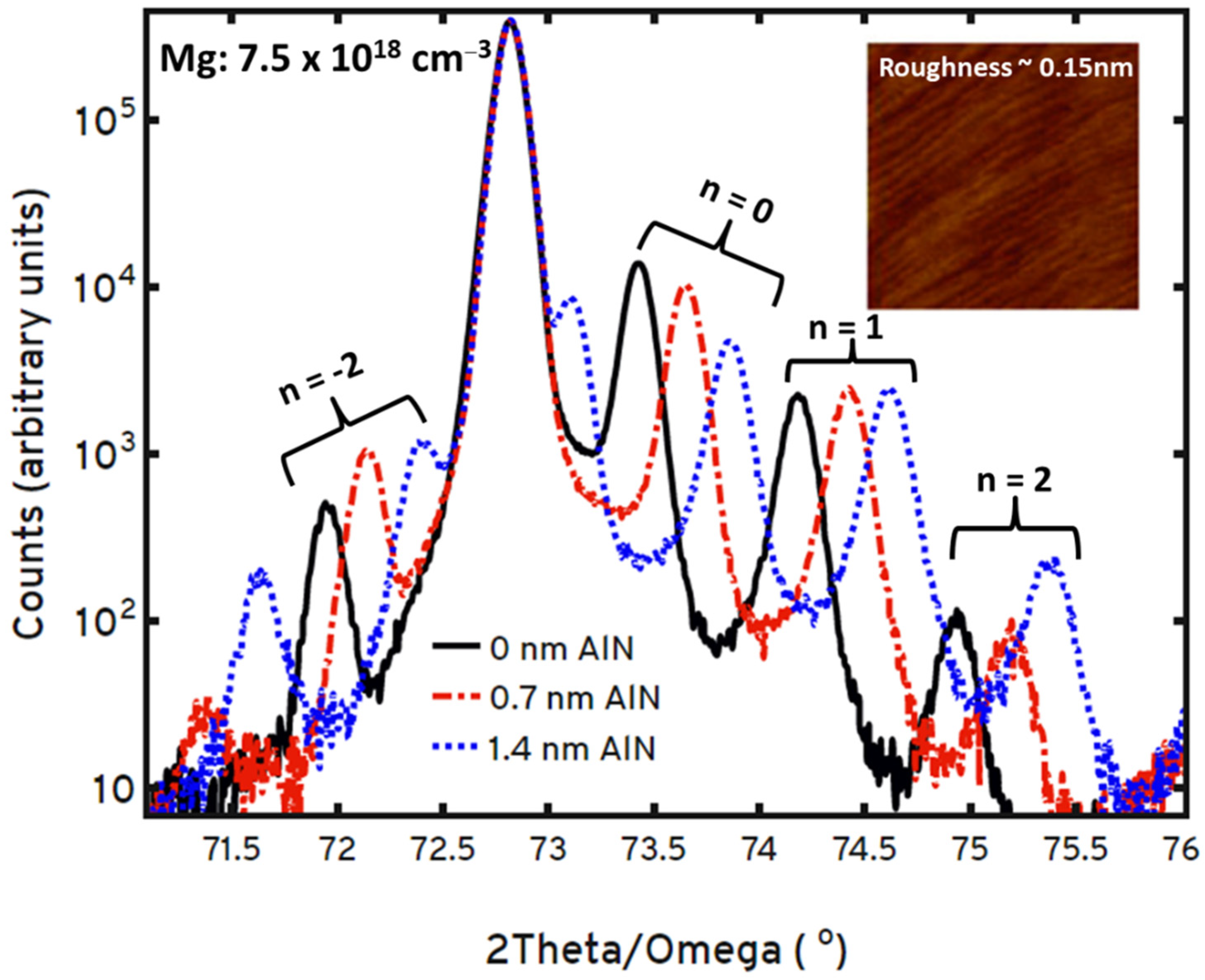
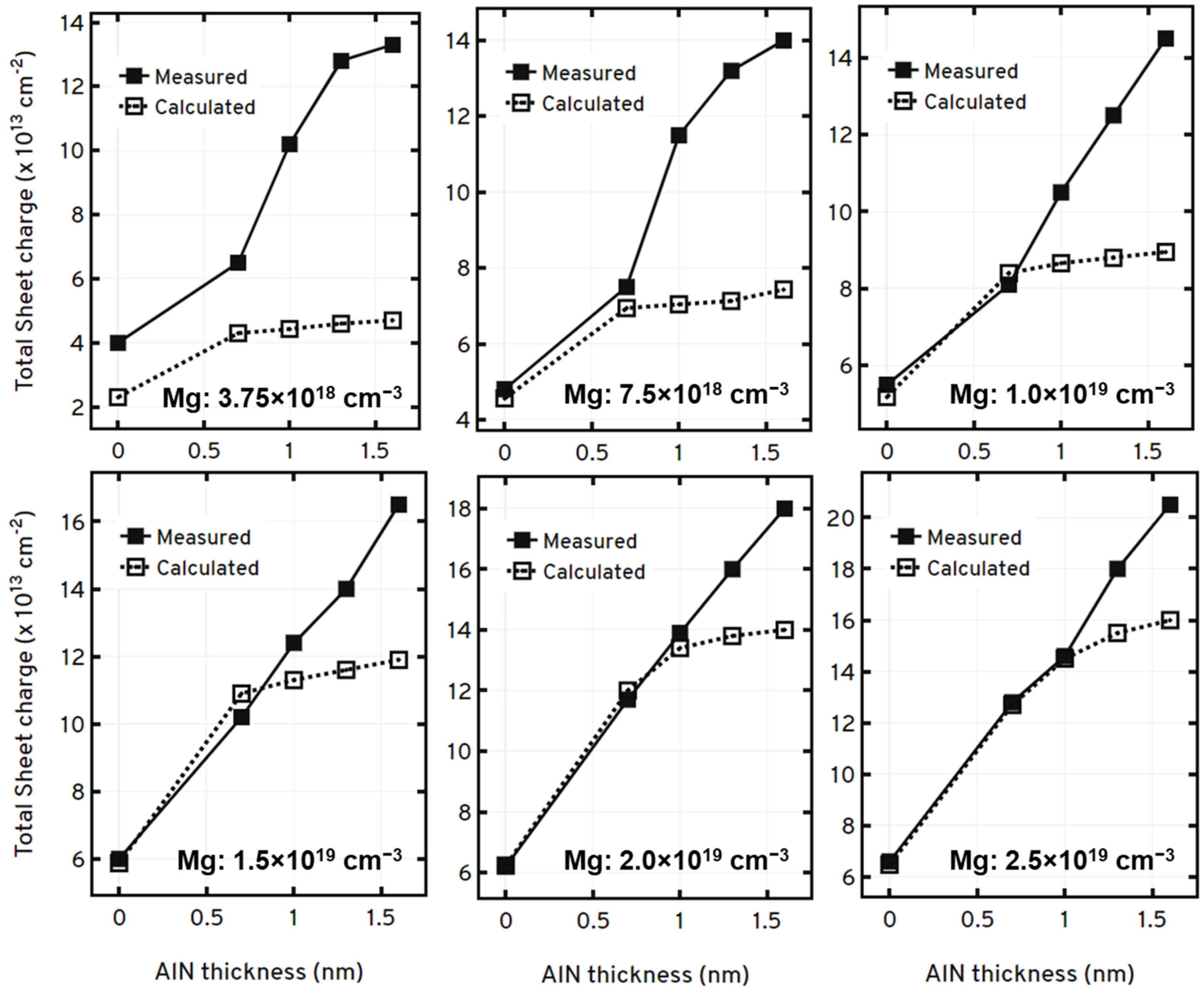

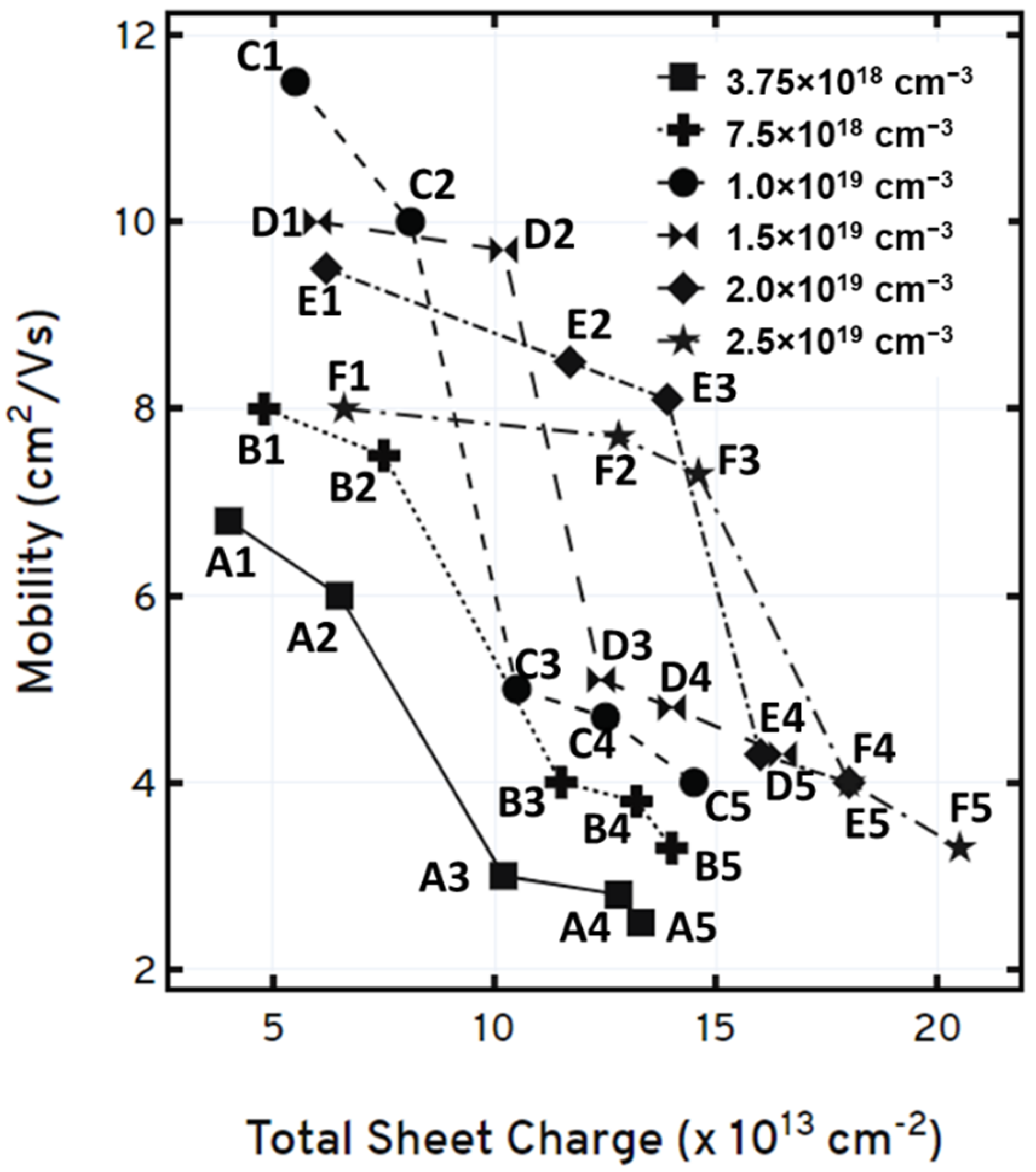
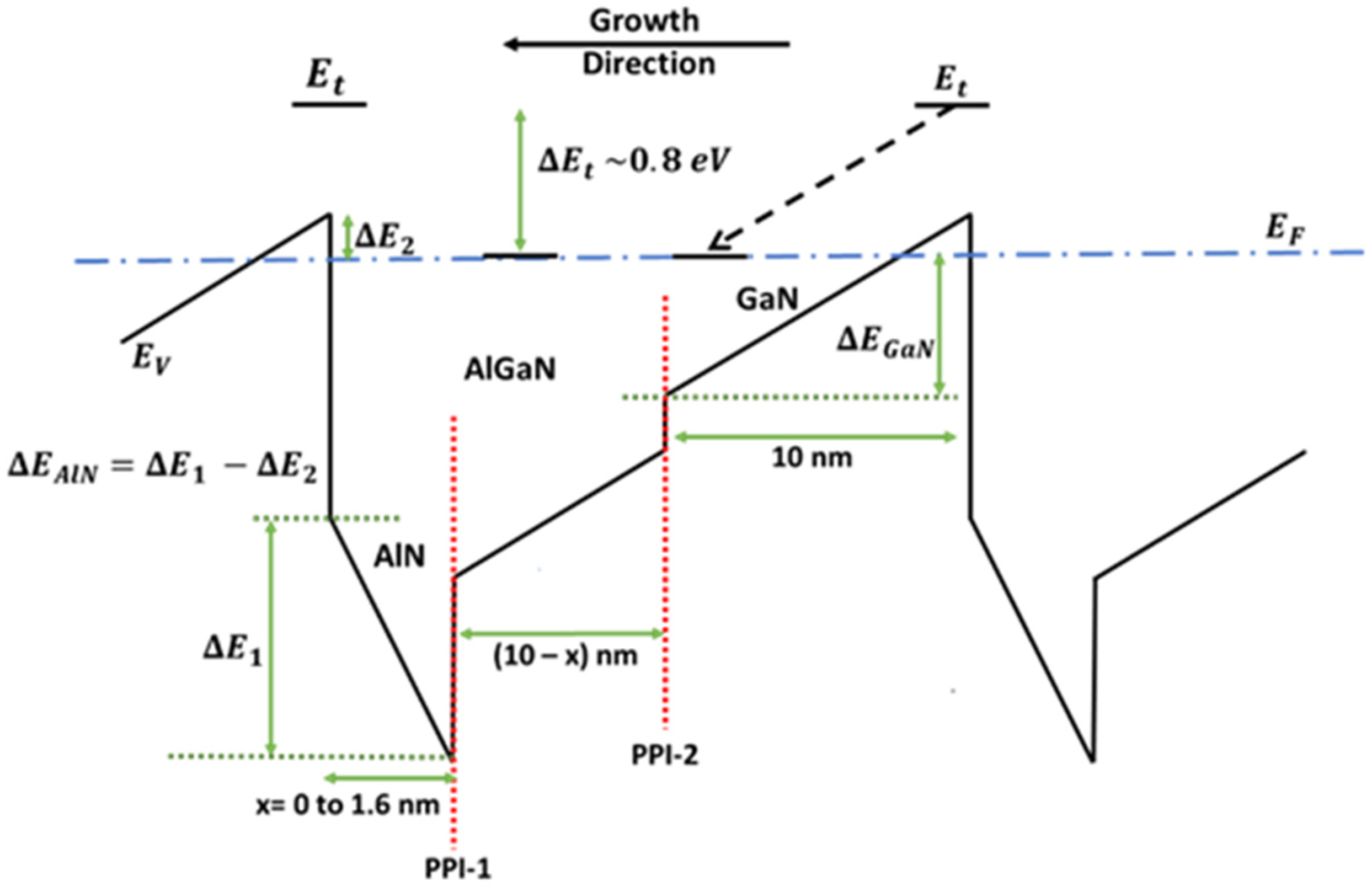
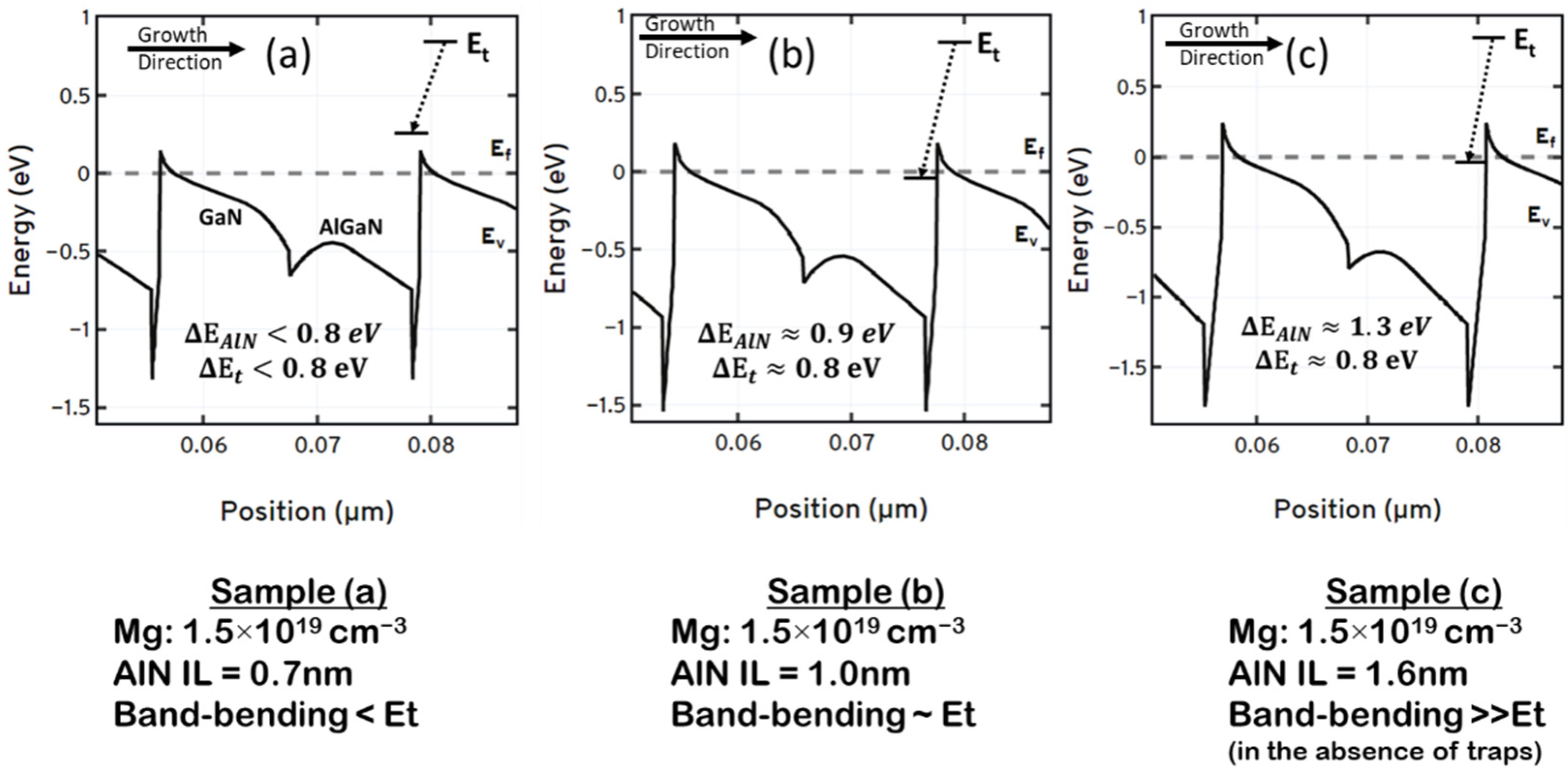
| Sample No. | Doping (×1018 cm−3) | AlN Layer Thickness (nm) | Traps at PPI-1 (Defined in Figure 6) | Traps at PPI-2 (Defined in Figure 6) | Effect of Traps on Mobility? |
|---|---|---|---|---|---|
| A-1 | 3.75 | 0 | Un-ionized | Ionized | No |
| A-2 | 3.75 | 0.7 | Un-ionized | Ionized | No |
| A-3 | 3.75 | 1.0 | Ionized | Ionized | Yes |
| A-4 | 3.75 | 1.4 | Ionized | Ionized | Yes |
| A-5 | 3.75 | 1.6 | Ionized | Ionized | Yes |
| B-1 | 7.5 | 0 | Un-ionized | Un-ionized | - |
| B-2 | 7.5 | 0.7 | Un-ionized | Ionized | No |
| B-3 | 7.5 | 1.0 | Ionized | Ionized | Yes |
| B-4 | 7.5 | 1.4 | Ionized | Ionized | Yes |
| B-5 | 7.5 | 1.6 | Ionized | Ionized | Yes |
| C-1 | 10 | 0 | Un-ionized | Un-ionized | - |
| C-2 | 10 | 0.7 | Un-ionized | Un-ionized | - |
| C-3 | 10 | 1.0 | Ionized | Ionized | Yes |
| C-4 | 10 | 1.4 | Ionized | Ionized | Yes |
| C-5 | 10 | 1.6 | Ionized | Ionized | Yes |
| D-1 | 15 | 0 | Un-ionized | Un-ionized | - |
| D-2 | 15 | 0.7 | Un-ionized | Un-ionized | - |
| D-3 | 15 | 1.0 | Ionized | Un-ionized | Yes |
| D-4 | 15 | 1.4 | Ionized | Ionized | Yes |
| D-5 | 15 | 1.6 | Ionized | Ionized | Yes |
| E-1 | 20 | 0 | Un-ionized | Un-ionized | - |
| E-2 | 20 | 0.7 | Un-ionized | Un-ionized | - |
| E-3 | 20 | 1.0 | Un-ionized | Un-ionized | - |
| E-4 | 20 | 1.4 | Ionized | Un-ionized | Yes |
| E-5 | 20 | 1.6 | Ionized | Ionized | Yes |
| F-1 | 25 | 0 | Un-ionized | Un-ionized | - |
| F-2 | 25 | 0.7 | Un-ionized | Un-ionized | - |
| F-3 | 25 | 1.0 | Un-ionized | Un-ionized | - |
| F-4 | 25 | 1.4 | Ionized | Un-ionized | Yes |
| F-5 | 25 | 1.6 | Ionized | Un-ionized | Yes |
Publisher’s Note: MDPI stays neutral with regard to jurisdictional claims in published maps and institutional affiliations. |
© 2022 by the authors. Licensee MDPI, Basel, Switzerland. This article is an open access article distributed under the terms and conditions of the Creative Commons Attribution (CC BY) license (https://creativecommons.org/licenses/by/4.0/).
Share and Cite
Krishna, A.; Raj, A.; Hatui, N.; Keller, S.; Mishra, U.K. Demonstration of Acceptor-Like Traps at Positive Polarization Interfaces in Ga-Polar P-type (AlGaN/AlN)/GaN Superlattices. Crystals 2022, 12, 784. https://doi.org/10.3390/cryst12060784
Krishna A, Raj A, Hatui N, Keller S, Mishra UK. Demonstration of Acceptor-Like Traps at Positive Polarization Interfaces in Ga-Polar P-type (AlGaN/AlN)/GaN Superlattices. Crystals. 2022; 12(6):784. https://doi.org/10.3390/cryst12060784
Chicago/Turabian StyleKrishna, Athith, Aditya Raj, Nirupam Hatui, Stacia Keller, and Umesh K. Mishra. 2022. "Demonstration of Acceptor-Like Traps at Positive Polarization Interfaces in Ga-Polar P-type (AlGaN/AlN)/GaN Superlattices" Crystals 12, no. 6: 784. https://doi.org/10.3390/cryst12060784
APA StyleKrishna, A., Raj, A., Hatui, N., Keller, S., & Mishra, U. K. (2022). Demonstration of Acceptor-Like Traps at Positive Polarization Interfaces in Ga-Polar P-type (AlGaN/AlN)/GaN Superlattices. Crystals, 12(6), 784. https://doi.org/10.3390/cryst12060784







